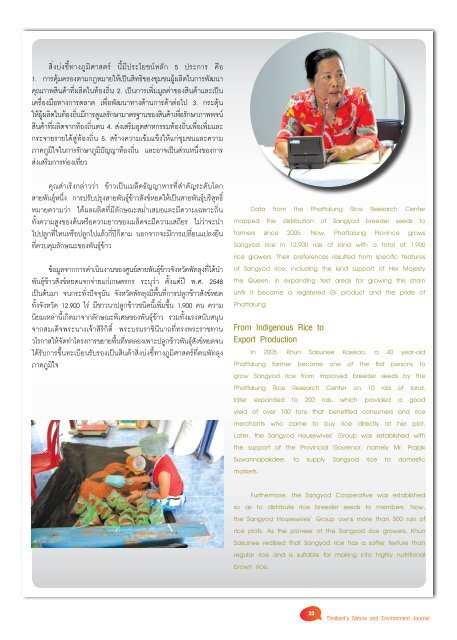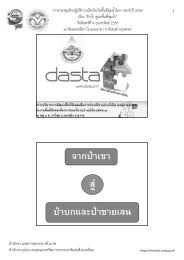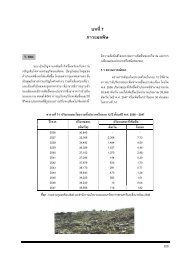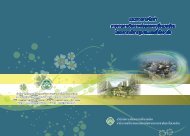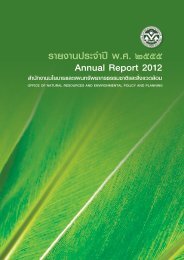ปีที่ 5 ฉบับที่ 3 กรกฎาคม-กันยายน 2552 - สำนักงานนโยบายและแผน ...
ปีที่ 5 ฉบับที่ 3 กรกฎาคม-กันยายน 2552 - สำนักงานนโยบายและแผน ...
ปีที่ 5 ฉบับที่ 3 กรกฎาคม-กันยายน 2552 - สำนักงานนโยบายและแผน ...
Create successful ePaper yourself
Turn your PDF publications into a flip-book with our unique Google optimized e-Paper software.
สิ่งบ่งชี้ทางภูมิศาสตร์ นี้มีประโยชน์หลัก 5 ประการ คือ<br />
1. การคุ้มครองตามกฎหมายให้เป็นสิทธิของชุมชนผู้ผลิตในการพัฒนา<br />
คุณภาพสินค้าที่ผลิตในท้องถิ่น 2. เป็นการเพิ่มมูลค่าของสินค้าและเป็น<br />
เครื่องมือทางการตลาด เพื่อพัฒนาทางด้านการค้าต่อไป 3. กระตุ้น<br />
ให้ผู ้ผลิตในท้องถิ ่นมีการดูแลรักษามาตรฐานของสินค้าเพื ่อรักษาภาพพจน์<br />
สินค้าที่ผลิตจากท้องถิ่นตน 4. ส่งเสริมอุตสาหกรรมท้องถิ่นเพื่อเพิ่มและ<br />
กระจายรายได้สู่ท้องถิ่น 5. สร้างความเข้มแข็งให้แก่ชุมชนและความ<br />
ภาคภูมิใจในการรักษาภูมิปัญญาท้องถิ่น และอาจเป็นส่วนหนึ่งของการ<br />
ส่งเสริมการท่องเที่ยว<br />
คุณสําเริงกล่าวว่า ข้าวเป็นเมล็ดธัญญาหารที่สําคัญระดับโลก<br />
สายพันธุ์หนึ่ง การปรับปรุงสายพันธุ์ข้าวสังข์หยดให้เป็นสายพันธุ์บริสุทธิ์<br />
หมายความว่า ได้ผลผลิตที่มีลักษณะสม่ําเสมอและมีความเฉพาะถิ่น<br />
ทั้งความสูงของต้นหรือความยาวของเมล็ดจะมีความเสถียร ไม่ว่าจะนํา<br />
ไปปลูกที่ไหนหรือปลูกไปแล้วกี่ปีก็ตาม นอกจากจะมีการเปลี่ยนแปลงยีน<br />
ที่ควบคุมลักษณะของพันธุ์ข้าว<br />
ข้อมูลจากการดําเนินงานของศูนย์สายพันธุ ์ข้าวจังหวัดพัทลุงที ่ได้นํา<br />
พันธุ์ข้าวสังข์หยดแจกจ่ายแก่เกษตรกร ระบุว่า ตั้งแต่ปี พ.ศ. 2548<br />
เป็นต้นมา จนกระทั่งปัจจุบัน จังหวัดพัทลุงมีพื้นที่การปลูกข้าวสังข์หยด<br />
ทั้งจังหวัด 12,900 ไร่ มีชาวนาปลูกข้าวชนิดนี้เพิ่มขึ้น 1,900 คน ความ<br />
นิยมเหล่านี้เกิดมาจากลักษณะพิเศษของพันธุ์ข้าว รวมทั้งแรงสนับสนุน<br />
จากสมเด็จพระนางเจ้าสิริกิติ์ พระบรมราชินีนาถที่ทรงพระราชทาน<br />
วโรกาสให้จัดทําโครงการขยายพื้นที่ทดลองเพาะปลูกข้าวพันธุ์สังข์หยดจน<br />
ได้รับการขึ้นทะเบียนรับรองเป็นสินค้าสิ่งบ่งชี้ทางภูมิศาสตร์ที่คนพัทลุง<br />
ภาคภูมิใจ<br />
Data from the Phattalung Rice Research Center<br />
mapped the distribution of Sangyod breeder seeds to<br />
farmers since 2005. Now, Phattalung Province grows<br />
Sangyod rice in 12,900 rais of land with a total of 1,900<br />
rice growers. Their preferences resulted from specific features<br />
of Sangyod rice, including the kind support of Her Majesty<br />
the Queen, in expanding test areas for growing this strain<br />
until it became a registered GI product and the pride of<br />
Phattalung.<br />
From Indigenous Rice to<br />
Export Production<br />
In 2005, Khun Saisunee Kaekao, a 40 year-old<br />
Phattalung farmer became one of the first persons to<br />
grow Sangyod rice from improved breeder seeds by the<br />
Phattalung Rice Research Center on 10 rais of land,<br />
later expanded to 200 rais, which provided a good<br />
yield of over 100 tons that benefited consumers and rice<br />
merchants who came to buy rice directly at her plot.<br />
Later, the Sangyod Housewives’ Group was established with<br />
the support of the Provincial Governor, namely Mr. Prajak<br />
Suwannapakdee, to supply Sangyod rice to domestic<br />
markets.<br />
Furthermore, the Sangyod Cooperative was established<br />
so as to distribute rice breeder seeds to members. Now,<br />
the Sangyod Housewives’ Group owns more than 500 rais of<br />
rice plots. As the pioneer of the Sangyod rice growers, Khun<br />
Saisunee realized that Sangyod rice has a softer texture than<br />
regular rice and is suitable for making into highly nutritional<br />
brown rice.<br />
23<br />
Thailand’s Nature and Environment Journal


